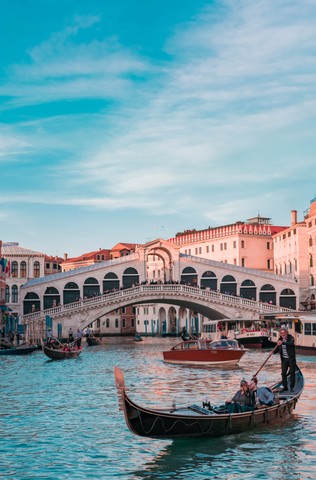A Guide to Lisbon’s Best Neighbourhoods
Different neighbourhoods are good for different things. Some neighbourhoods, like Cais do Sodré and the Bairro Alto, are great for doing out in, but may not be the best neighbourhood to stay in or live in. Lots of people like to stay in Alfama when they visit Lisbon, but it may not be the best neighbourhood to stay in if you’re planning on living in Lisbon long term. And so on.
The best neighborhoods to explore on your next trip to Lisbon
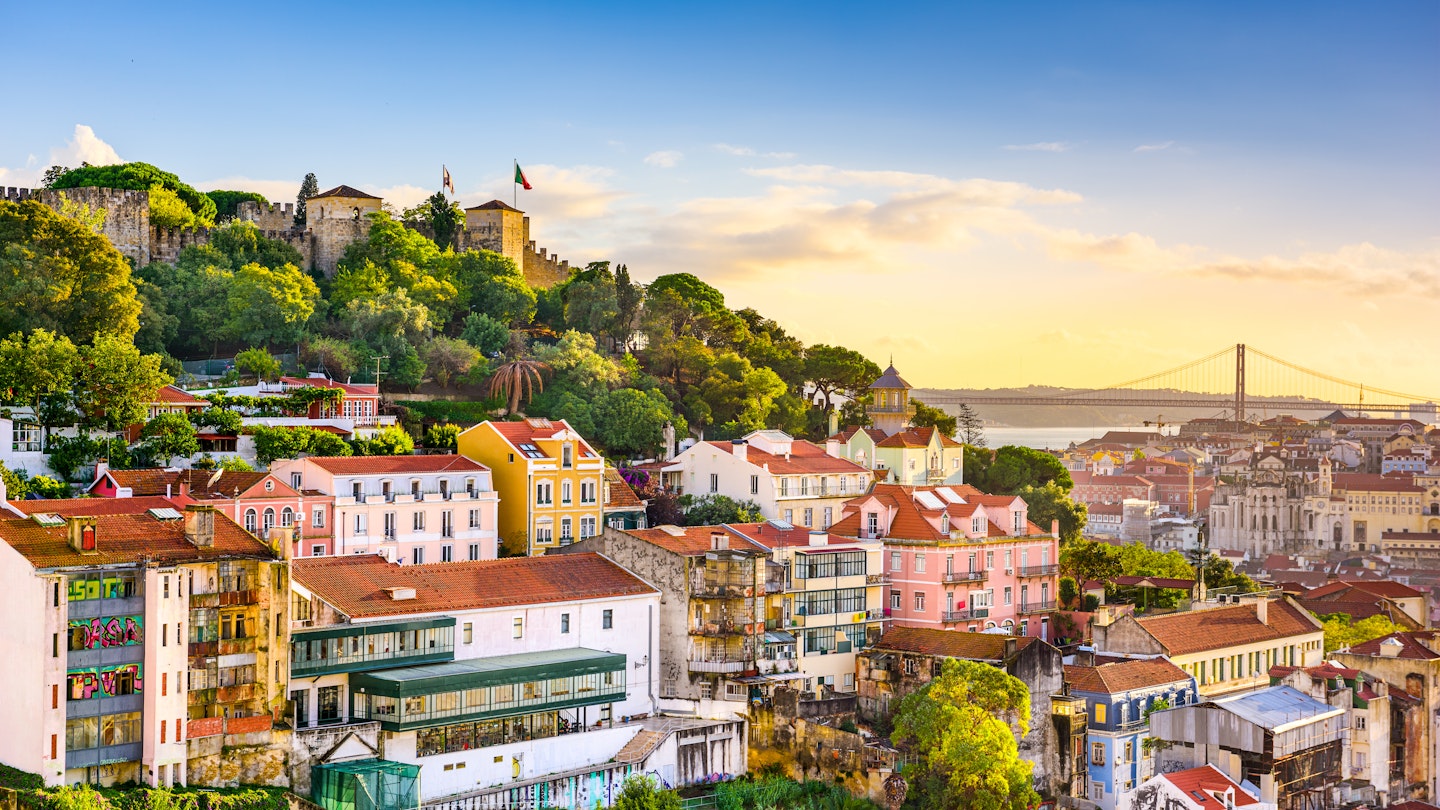
At first sight, Lisbon is a colorful cluster of tile-covered buildings cascading downhill along the north bank of the Tagus River. But although the boundaries between them might blur, each of Lisbon’s neighborhoods has its own distinct personality.
A few days might be enough to tick off many must-see sights in Lisbon, but don’t rush the journey. Instead take in the atmosphere of Lisbon’s neighborhoods one block at a time.
Get local insight on destinations all over the world with our weekly newsletter delivered to your inbox.
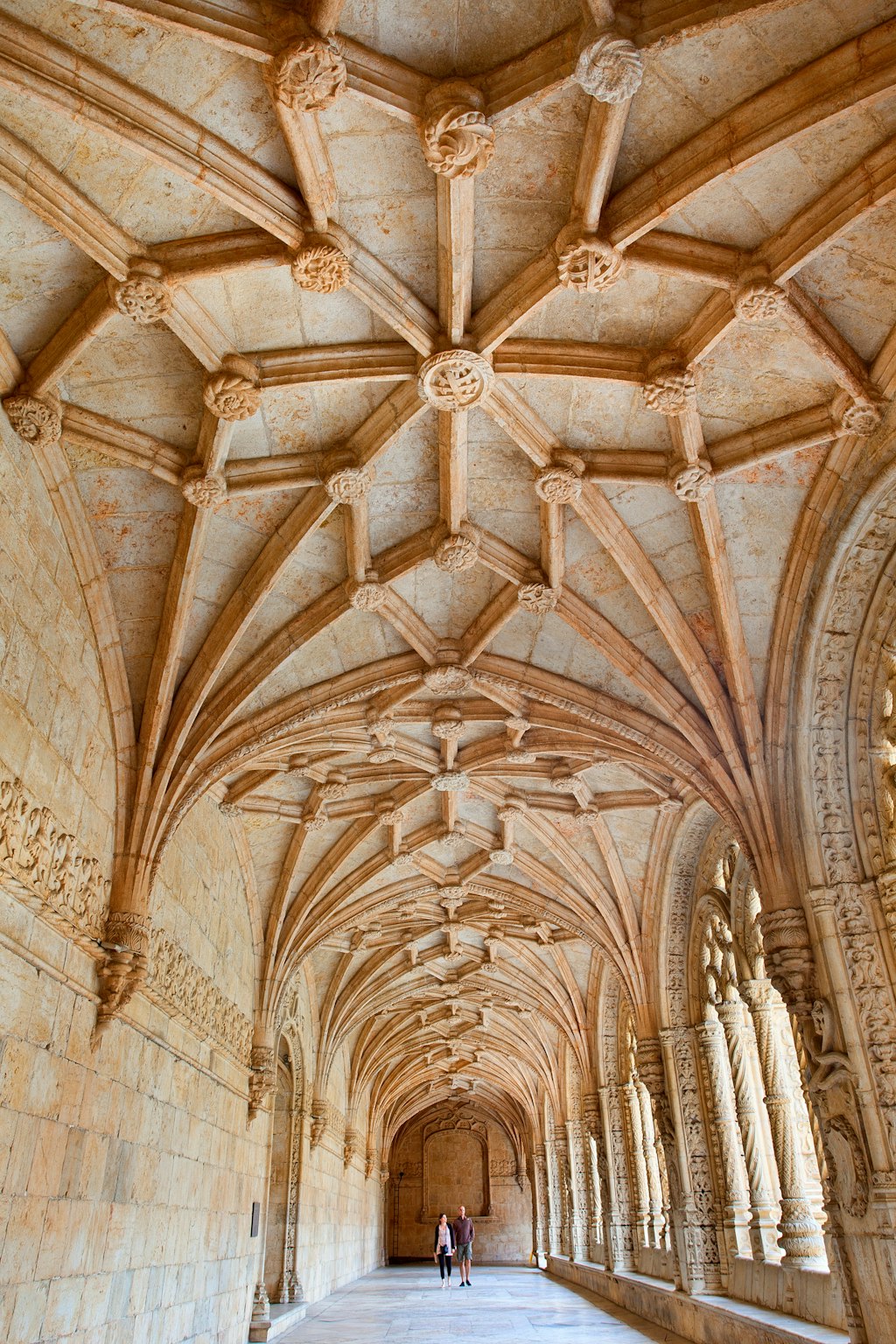
Belém
Best neighborhood for day trips to the beach
With sprawling manicured gardens, expansive riverside squares and Manueline-style monuments honoring the seafaring voyagers of the 15th century, Belém often gets the attention of travelers for no longer than a day. For those on a short visit, it doesn’t take more than a morning to visit Mosteiro dos Jerónimos, Padrão dos Descobrimentos and Torre de Belém, including a pit stop at Pastéis de Belém for the famous custard tart – best eaten straight-from-the-oven, warm and sprinkled with cinnamon.
But this Lisbon neighborhood, once the suburban summer refuge of royals, has an ideal – and often overlooked – location for those who want to wind down from their urban exploration with time at the beach. Either take the ferry across the river to Trafaria, and a bus from there to the beaches at Costa da Caparica, or hop on the train to Carcavelos.
Accommodations in Belém are a mix of international chain hotels, high-end luxury spots, and a few budget-friendly hostels and guesthouses. Riverside cafes and restaurants cater mostly to tourists, but Lisbon’s city center is just a 10-minute train ride away if you’re looking for more variety and eating spots with a more local feel.
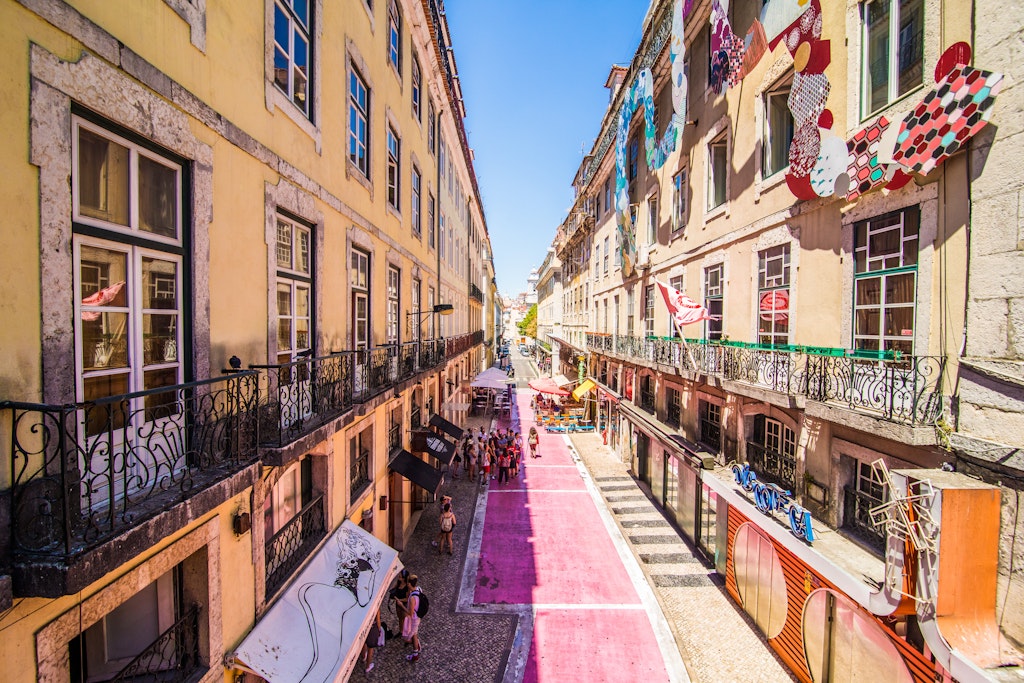
Madragoa and Santos
Best neighborhoods for digital nomads and slow travelers
If you ask locals where Santos ends and Madragoa begins, you’ll rarely get the same answer. Madragoa and Santos are usually bundled together as one neighborhood, and no one seems to mind them often being referred to as a single place. Offices, schools, Instagrammable cafes with decent and free wi-fi, a mix of traditional and modern restaurants, and the vibe of a typical Lisbon neighborhood are the gist of the Santos/Madragoa duo: bustling business area by day and a quiet residential neighborhood after office hours.
Fully equipped and furnished short-term rental apartments and a cluster of coworking spaces a short walk or train ride away in nearby Cais do Sodré and Baixa-Chiado have turned Santos and Madragoa into a coveted spot for digital nomads. Fairly well-served by public transit, grocery stores, affordable cafes and restaurants, it’s the place to stay for travelers looking for a slice of local Lisbon life.
Museu Nacional de Arte Antiga is one of the few must-see sights in this neighborhood, but the monuments and landmarks aren’t the reason for a visit. Instead, roam the streets and take in the balance between the old and the new, tourist-centered businesses and family-owned establishments, riverside bars and cobblestoned backstreets with laundry hanging out to dry.
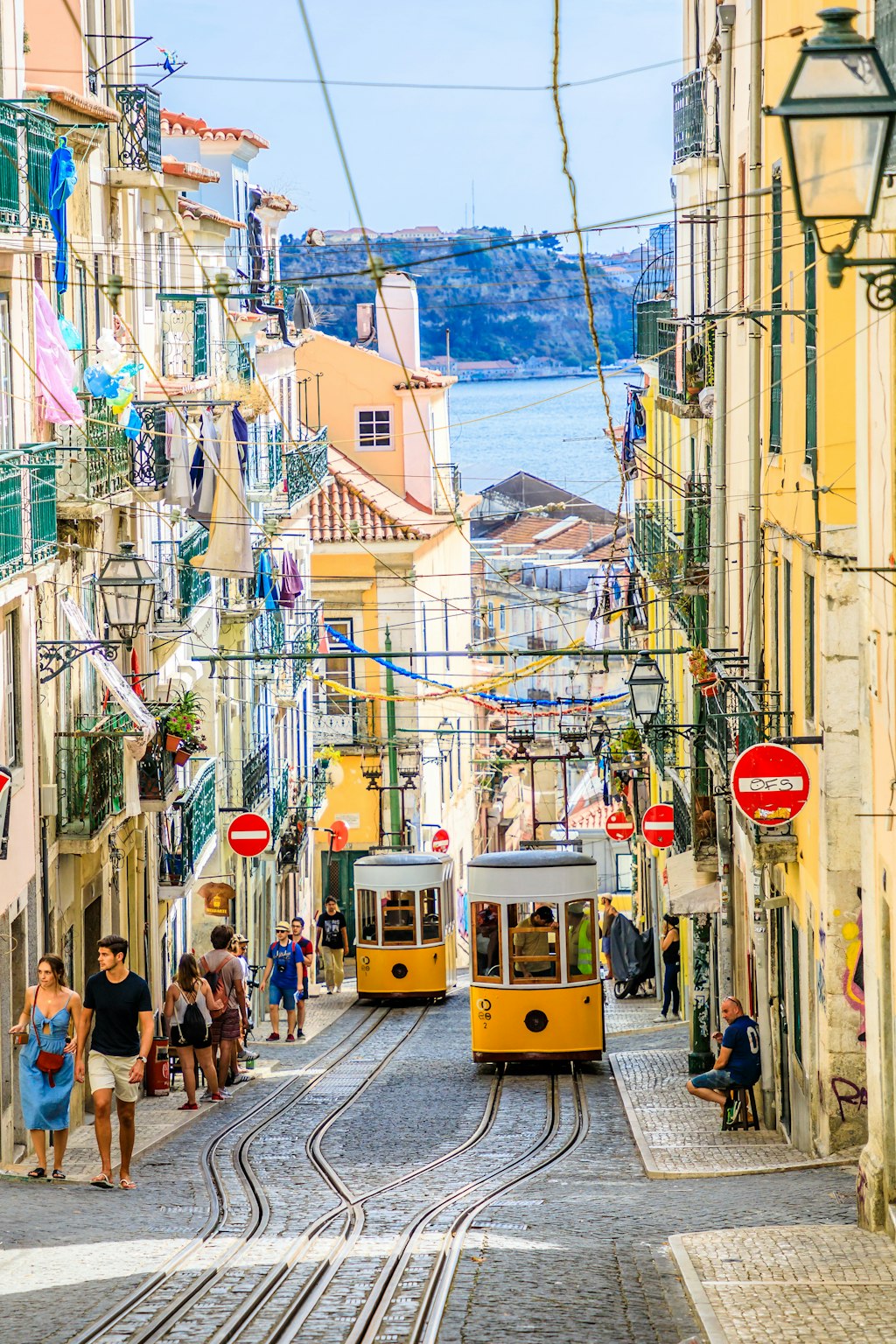
Baixa, Chiado and Rossio
Best neighborhoods for shopping
All the historical and cultural layers of Lisbon overlap here. Take the time to stroll through the post-1755 earthquake rebuilt Baixa, discover hilly Chiado and its picturesque squares, and the wavy black-and-white patterns of calçada Portuguesa (Portuguese pavement tiles) in Rossio. To fully see the contrast between these neighborhoods, head to the viewpoint at the top of Arco da Rua Augusta.
After a morning of sightseeing, go out window shopping or buy some souvenirs. At Baixa’s main street, Rua Augusta, you’ll find old traditional stores coexisting with tourist traps overflowing with cheap fridge magnets, and poor value restaurants with questionable menus. Rossio is all about big plazas and their statues, flanked by overpriced souvenir shops with a few local gems thrown in the mix, like the 19th-century hattery Azevedo Rua. Chiado has the old-town charm of historical cafes like A Brasileira and Pastelaria Benard, ideal for a break after perusing the upscale shops at Rua Garrett.
These touristy neighborhoods have Lisbon’s densest concentration of hotels, hostels, cafes, restaurants and shops, making it the best area to stay when visiting Lisbon. Travelers have direct access to two Metro lines (Blue and Green), the urban train to Sintra, and myriad buses and trams. Historic neighborhoods and top landmarks are a short – but uphill – walk away.
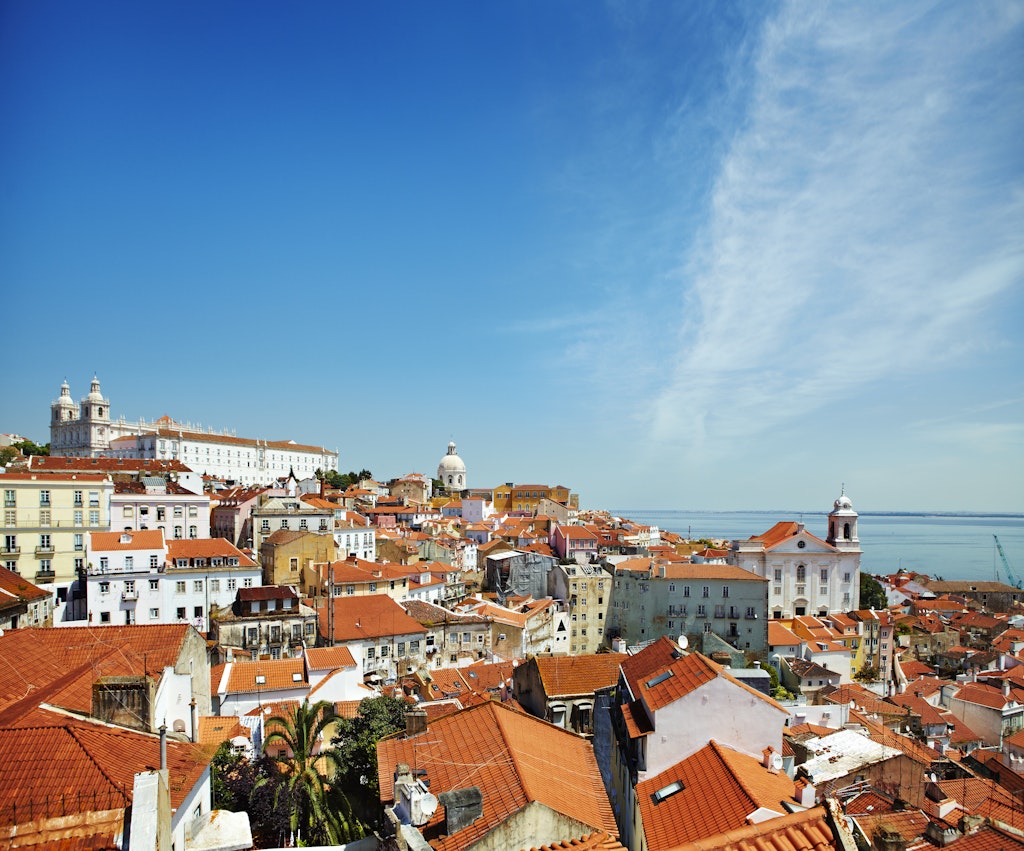
Mouraria and Alfama
Best neighborhoods for sightseeing
The neighborhood of Mouraria has narrow streets flanked by full-to-the-brim stores (where you can buy everything from power adapters to spices in bulk), traditional restaurants busy at lunchtime, and locals speaking dozens of languages. In Alfama, you’ll find sunlit terraces, terracotta rooftops and Lisbon’s most famous viewpoints.
These two neighborhoods are the oldest in Lisbon and the heart of the city. Visitors will find top landmarks here, including Sé de Lisboa, Museu do Aljube, Museu do Teatro Romano, Castelo de São Jorge and Panteão Nacional. But the real magic happens as you wander through the cobblestoned streets, up and down the hills, getting lost amid tiled buildings, interior courtyards and pieces of Lisbon’s medieval walls.
Small- to mid-sized boutique hotels and short-term rentals are the most popular accommodation options in Mouraria and Alfama. Stay here if you want a hint of that old-town authenticity and don’t mind the tourist crowds and fewer transportation options. Both Alfama and Mouraria are best explored on foot, with the occasional hop onto one of the classic yellow trams to dodge a steeper hill.
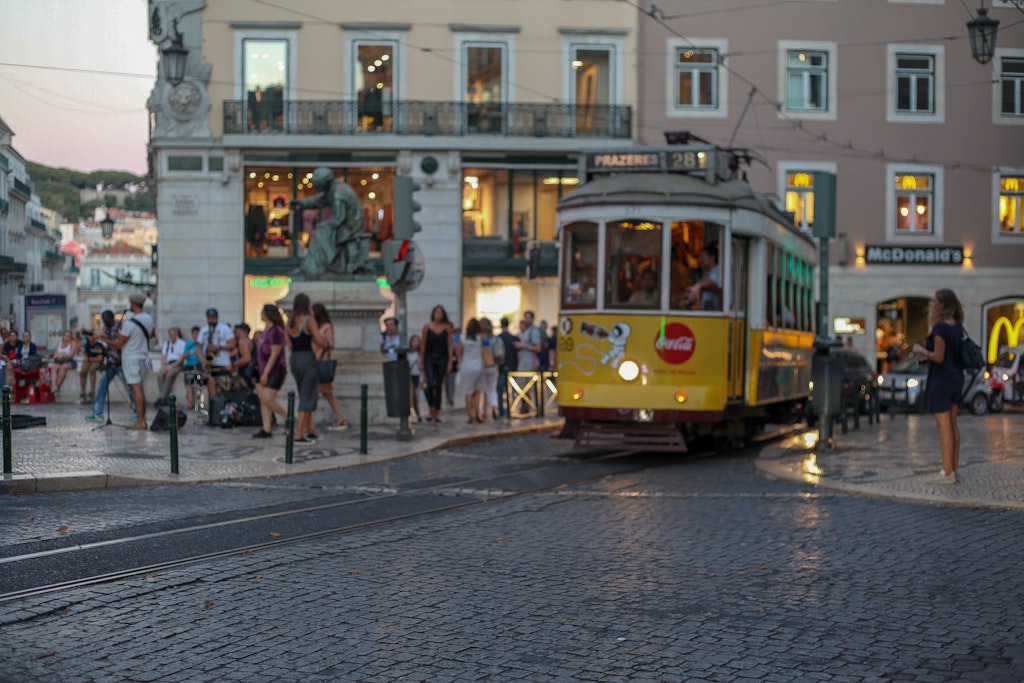
Bairro Alto and Cais do Sodré
Best neighborhoods for restaurants and nightlife
Weekend crowds flow between Bairro Alto and Cais do Sodré, seeking out the next bar stop. If you want to do as locals do, start with dinner and bar-hopping in Bairro Alto and, closer to last call (usually around 2am), head downhill to the nightclubs at Cais do Sodré.
Bairro Alto is the more charismatic of the two, with patrons gathering outside the tiny bars with a drink in hand before heading off to wherever the night leads them. In the post-democratic revolution of 1980s Lisbon, this district became the city’s bohemian hot spot, where students and artists flocked, yearning for the musical and intellectual freedom that thrived here after five decades of a conservative dictatorship. Although things have changed a bit since then, BA (for short) is still seen as the affordable, unpretentious night-out spot of Lisbon.
On the other hand, Cais do Sodré is Lisbon reinvented. Once a shabby haunt for on-leave sailors, cheap and sketchy bars were the norm. These days, only the old names and decor of those places exist, a nod to how that part of the city went from a red light district of sorts to one of Lisbon’s most popular nightlife neighborhoods. Pensão Amor is the best example of that past and present fusion.
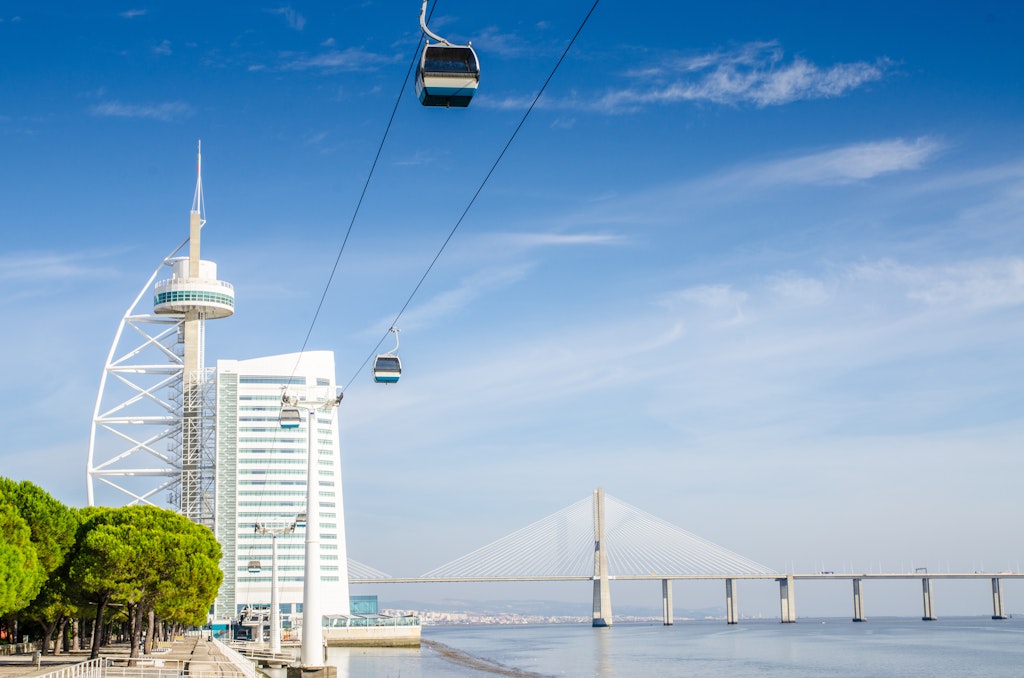
Parque das Nações
Best neighborhood for families
This eastern neighborhood of Parque das Nações grew around the former grounds of Expo 1998, and it’s the newest part of Lisbon. Although the city center is a train or metro trip away, it doesn’t take more than 30 minutes to reach must-see attractions. The urban park itself is a great playground for kids, but the real family-friendly gems are the Oceanário, one of the largest aquariums in Europe, and Pavilhão do Conhecimento, an interactive science museum for kids and grownups.
Parque das Nações is one of the best neighborhoods in Lisbon for families, with big chain hotels concentrated between the park and the Oriente station, the public transit hub for trains, metro and buses. A good mix of grocery stores, small local food shops, and family-friendly restaurants make it easy for planning meals before or after a day of sightseeing across town.
Buy the Portugal travel guide

Lonely Planet’s Portugal is our most comprehensive guide that covers all the country has to offer. Ideal for travelers that are visiting for an extended time and want to tailor their own trip. Lose yourself in Lisbon, explore fairytale Sintra, and sip port in the centuries-old wineries of Porto – all with your trusted travel companion.
Buy the Portugal travel guide

Lonely Planet’s Portugal is our most comprehensive guide that covers all the country has to offer. Ideal for travelers that are visiting for an extended time and want to tailor their own trip. Lose yourself in Lisbon, explore fairytale Sintra, and sip port in the centuries-old wineries of Porto – all with your trusted travel companion.


Aug 4, 2023 • 11 min read
Our writers all over Europe report on how visitors can cope with heat waves, rainy spells and other conditions in a summer of weird weather.
A Guide to Lisbon’s Best Neighbourhoods

Although Lisbon is quite a small city, it’s made up of lots of different neighbourhoods and each one has its own unique character.
Different neighbourhoods are good for different things. Some neighbourhoods, like Cais do Sodré and the Bairro Alto, are great for doing out in, but may not be the best neighbourhood to stay in or live in. Lots of people like to stay in Alfama when they visit Lisbon, but it may not be the best neighbourhood to stay in if you’re planning on living in Lisbon long term. And so on.
Regardless of what they’re best for, each neighbourhood has its own vibe and something to offer. This article gives a run down on some of Lisbon’s most popular and most interesting neighbourhoods.
Baixa
Baixa is the most central neighbourhood in Lisbon, and you’ll end up here regardless of whether you plan to go here or not. The neighbourhood is extremely flat, with large, grand buildings and equally grand squares. The grandest of all the streets is Rua Augusta, a large pedestrian street that runs through central Baixa all the way to Praça do Comércio.

Featured Articles

If you’re planning to move to Portugal, you may have discovered that you need a NIF number and a Portuguese…
If you live in Portugal, you’ll need a NIF (the full name is Número de Identificação Fiscal, but more people…

So you’ve decided to learn Portuguese and specifically European Portuguese (as opposed to Brazilian Portuguese). Maybe you’ve decided to move to…
As well as Praça do Comércio, another popular attraction that you’ll find in Baixa is the Elevador Santa Justa. This elevator was designed by Raul Mesnier de Ponsard, a student of Gustave Eiffel who famously designed the Eiffel tower in Paris. If you take it the elevator, it’ll take you all the way up to Largo do Carmo and to where the ruins of the Carmo Convent are located.
Baixa is very touristic, and is mainly made up of over-priced restaurants, souvenir shops, and hotels as well as a few banks. There are still a few gems, including some very nice cafes, but this is a good summary of the majority of Baixa.
It’s a very quiet area in the evening, as there are very few bars here, but it’s not a very residential area.
Avenida da Liberdade
Avenida da Liberdade is an equally grand part of Lisbon, if not grander, that connects Restauradores square in Baixa with Marques de Pombal. Built in 1879, it was modeled after the boulevards in Paris and it feels incredibly Parisian. The streets here are wide and lined with trees and quiosks where you can relax and grab a coffee or a glass of wine, and almost every shop here is designer. If you’re looking to spend a little money, this is where you’ll find brand names like Emporio Armani, Cartier, and Louis Vuitton.
Chiado
Although Avenida da Liberdade is where you’ll find all the high-end brand names, Chiado is really Lisbon’s main shopping district. Here you’ll find everything from boutique clothing stores to household brand names, as well as several iconic stores including Livraria Bertrand: the world’s oldest bookstore.
Like Baixa and Avenida da Liberdade, the area is home to some incredibly grand buildings. During the 19th and early 20th century, Chiado attracted prominent Portuguese writers like Fernando Pessoa and Eça de Queiroz who used to write from some of the cafés here. Many of those cafés still exist, most famously Café A Brasileira, which has a statue of Pessoa outside.
Chiado connects several neighbourhoods together, like Baixa and Cais do Sodré, so it can be quite a busy neighbourhood with plenty of both tourists and locals. Because of this, it’s somewhere that you’ll more than likely end up walking through at least once.
Alfama
Alfama is the oldest neighbourhood in Lisbon, and one of the few neighbourhoods to survive the 1755 earthquake. Because of its age, the layout is almost a labyrinth of narrow streets that wind around the side of the hill below the São Jorge Castle. It’s known for its fado houses, and its incredibly traditional vibe, and is always a hit with visitors to Lisbon.
Alfama is one of the neighbourhoods that’s been most heavily impacted by Lisbon’s tourism boom. While the neighbourhood was traditionally very working-class, in recent years large numbers of its residents have moved out to make way for Airbnbs and other apartment rentals. Many businesses also moved, and have been replaced by souvenir shops and petiscos restaurants.
Although the neighbourhood is in danger of losing its soul, many of the older residents still remain and you can still get a sense of the neighbourhood’s unique feel. One of the best times to visit is in June, during the Santo António festival when the neighbourhood really comes alive. Otherwise, be sure to visit one of the many fado houses and experience this unique genre of Portuguese music.
Príncipe Real
Made up of boutique clothes shops and trendy restaurants, Príncipe Real is one of Lisbon’s most popular neighbourhoods – both to visit and to live in. Although it’s situated right next to the Bairro Alto, one of Lisbon’s most popular nightlife areas, Príncipe Real is much, much tamer.
With a beautiful park, miradouros with incredible views of the city, this is a beautiful neighbourhood to wander through and grab a cup of coffee or grab a bite to eat. It’s also one of the most desired neighbourhoods to live in, particularly with successful artists.
On Saturday mornings, there’s a farmers’ market with stalls selling organic, health-conscious, and eco-friendly products from producers in Lisbon and from right across Portugal.
Graça
Although Graça is located next to touristy neighbourhoods like Alfama and Castelo, the restaurants and pastelarias are still very traditional, very Portuguese, and very affordable.
It is quite popular with tourists, particularly for its beautiful Miradouro da Graça, but generally only with those that manage to get on Tram 28: Graça is on one of the highest points in the city, and walking up the hill can be pretty tough if you’re not used to it.

If you do make it to the top, though, it’s definitely worth it. Graça has some of the best views of the city.
Bairro Alto
The Bairro Alto is mainly associated with nightlife: the area is made up of hundreds of tiny bars, as well as restaurants and shops. It’s somewhere you go to grab a cheap beer or caipirinha, and then wander around outside chatting to whoever you bump into.
Although there are a few shops open during the day, including a few small independent boutiques, the neighbourhood is very quiet during the day. At night it’s the opposite, though, which is why it isn’t usually the best place to live in or even to visit.
That’s not to say everywhere here is noisy. There are plenty of apartments and small hotels that aren’t on the busy streets, or that have managed to soundproof themselves, and the reviews will definitely tell you if the accommodation falls into this category.
Cais do Sodré
Cais do Sodré is another area that’s popular at night, particularly around the “Pink Street,” although it’s only really become popular in the past few years. The Bairro Alto used to be the main area for nightlife but, as more and more bars and restaurants have opened up in Cais do Sodré, this area has quickly become one of the most popular neighbourhoods to go out in.

Unlike the Bairro Alto, Cais do Sodré gets quite a bit of foot traffic during the day as well. There are plenty of cafés, restaurants, and shops here, and it’s also home to the very popular Time Out food market.

Like the Bairro Alto, this area can be quite noisy. It really depends where your apartment or hotel is located, though, as there are plenty of side streets which are very quiet at night.
Belém
Belém is the last neighbourhood in Western Lisbon and, after that, you’re officially out of Lisbon. It’s home to several famous attractions and monuments including Mosteiro dos Jerónimos (Jerónimos Monastery), Torre de Belém (Belém Tower), and the Padrão dos Descobrimentos (Discoveries Monument). It’s also home to several museums and art galleries, including Museu Coleção Berardo and the MAAT.

Perhaps even more popular than all of those things is Pastéis de Belém, the original makers of the pastel de nata (Portuguese custard tart). Every day, thousands of people queue up to try Portugal’s most famous dish and the queues usually extend far down the street.

Although this is quite a touristy neighbourhood, it’s fairly quiet at night. Although there are plenty of hotels and Airbnbs here, most tourists come for the day and go back to the city centre afterwards. Parts of Belém are actually quite residential, particularly where Belém begins to connect with neighbouring Restelo and Ajuda.
Campo de Ourique
Campo de Ourique is a residential and fairly upmarket neighbourhood that tends to attract young professionals and young families. It’s made up of lots of fashionable restaurants, coffee shops, and independent boutiques. It’s also home to the Mercado de Campo de Ourique, which is like a much smaller (and less well-known) version of the Time Out Market in Cais do Sodré.

Alcântara
Alcântara was traditionally a working-class neighbourhood but has become very popular in recent years. Most of this is because of the LX Factory, a complex of old factory builds that has been regenerated into an area with lots of hipster coffee shops, designers, restaurants, and co-working spaces.

Although Alcântara has definitely become more popular, the rest of the neighbourhood is still very traditional. There are plenty of great traditional restaurants and pastelarias, and the district still has a great community feel.
It’s located right next to the 25 de Abril Bridge, which not only means that you get beautiful views of it but also means it’s very easy to get to the other side of the water if you have a car.
Santos
Situated just outside of Lisbon’s core city centre lies the quiet, residential neighbourhood of Santos. Known for its design school, IADE, and its design shops, the area is popular with art lovers and art students.
The area is fairly quiet and non-touristic as it’s that little bit too far from the main hub. Restaurants and cafes are less crowded, and the neighbourhood has a very calm feel to it.
Mouraria
Mouraria is one of Lisbon’s multicultural neighbourhoods. It’s home to people from all over the world, but mainly from Bangladesh, China, India, Pakistan, and Mozambique.
The neighbourhood has actually been multicultural for a lot of Lisbon’s history. When D. Afonso Henriques took Lisbon back from the Moors in the 12 th Century, he allowed the Moors to live in this neighbourhood. They continued to live there for another 300 years until they were expelled from the city along with the Jews.

Although the area is slowly becoming more and more gentrified, particularly around Martim Moniz Square, some people may still feel uneasy particularly at night. It is definitely one of Lisbon’s most interesting neighbourhoods culturally, especially if you want to eat something other than Portuguese food.
Parque das Nações
Parque das Nações is a part of Lisbon that was redeveloped when Lisbon was hosting Expo ’98, and has since become a very popular part of Lisbon to live in. It’s generally fairly quiet here except when there’s a concert or conference (e.g. Web Summit) taking place.

This part of Lisbon probably won’t appeal to a lot of tourists. It’s mainly made up of high-rise residential buildings and hotels, and most of the buzz is located around the Vasco da Gama shopping centre. Because most of the apartments are new, the houses are often much better quality than those in the centre of Lisbon. Although this does mean the apartments are nice to live in, the neighbourhood does lack the traditional neighbourhood feel that you get in most of the city centre.
Marvila
Although it’s located quite far outside of Lisbon City Centre, Marvila (and nearby Beato) is one of Lisbon’s most up-and-coming neighbourhoods. In the past few years, it has quickly transformed from being a former industrial wasteland into one of the most desireable places to live. Abandoned warehouses have been converted into studios, craft beer breweries, and art galleries, and young Lisboetas have taken up residence in what was once cheaper accommodation.
James Cave is the founder of Portugalist and the author of the bestselling book, Moving to Portugal Made Simple. He has visited just about every part of Portugal, including Madeira all nine islands of the Azores.
Originally published: January 2019 and Last Updated: July 24, 2023.
The Coolest Neighbourhoods in Lisbon

The views from Miradouro da Graça are among the finest in Lisbon | Marina Watson Peláez / © Culture Trip
Nina Santos
06 September 2022
Ditch the crowds and discover the best under-the-radar neighbourhoods in Lisbon, Portugal – from the lively Bairro Alto to the foodie hotspots of Cais do Sodré.
View All Trips
You’d be hard-pressed to find a traveller who had visited Lisbon and didn’t rate it as one of Europe’s coolest capitals. Amongst its cobblestone streets and pastel-shaded houses exists a glut of quirky neighbourhoods, squirrelled away beyond the usual tourist trail. Whether you’re looking for boutique shops or a spot for post-sunset drinks, these are the hippest districts in Lisbon.

Take a spin to find your perfect small-group trip destination
Passports ready?
Your next destination is.
And if you’re interested in exploring more of Portugal – and getting to know Portuguese culture beyond the city – you can now travel with Culture Trip on a nine-day adventure taking you from Porto to Lisbon, with visits to the lush vineyards of Alentejo and the Douro Valley along the way.
Baixa and Rossio, for Lisbon’s main landmarks

© Culture Trip
The most tourist-friendly neighbourhood during the day is that between Baixa and Rossio, where many of Lisbon’s main landmarks, shopping and dining opportunities can be found. Although ‘downtown’ is a term used loosely to describe a few neighbourhoods, this is Lisbon’s real downtown area. It is also the main part of the city that was destroyed during the famous earthquake of 1755 and rebuilt in the late 18th century. A few key sites include Livraria Bertrand (the oldest bookstore in the world still trading), the elaborate Brasileira café, the elegant, bright-yellow Praça do Comércio and the Rossio train station.
Bairro Alto, for a boho vibe
Market, Architectural Landmark

© Hemis / Alamy Stock Photo
If you want to know where everyone is on Saturday night, chances are good that it’s Bairro Alto. This windy, hilly neighbourhood is filled with bars and has a bohemian vibe, making it one of the coolest places in the city. There are also restaurants, cafés, tattoo parlours and hostels in addition to the ever-present historical landmarks. It’s not just for hanging out in, either; the side streets are filled with apartments. Those who can handle the busy weekends love the central location.
Alfama, for history and charm

© Culture Trip
Alfama is perhaps the most charming part of Lisbon, not to mention its oldest district. This is the place to go if you want to eat a traditional meal accompanied by equally traditional fado music. Narrow, winding medieval alleys are common all over Lisbon but nowhere more so than in Alfama, where the roads have been described as labyrinthine. If you know where you’re going, this maze leads to landmarks in other parts of the city including the Castelo de São Jorge and the beautiful lookout point at Portas do Sol.




CARIBBEAN COLOMBIA
Discover Colombia’s Caribbean coast, from Cartagena to Palomino via jungles, rivers and islands.
View Trip
Alcântara, for a location by the river

© Culture Trip
Technically, Alcântara is a parish of the district of Lisbon but locals consider it part of the city. Situated between downtown and Belém, it’s a neighbourhood along the river where visitors will find Docas de Santo Amaro (a dock filled with bars and restaurants) and the LX Factory (a renovated factory building complex that’s been converted into shops, offices, restaurants and more).
Príncipe Real, for trendy stores and grand buildings
This trendy neighbourhood is west of Avenida da Liberdade and north of Bairro Alto. The buildings here are grander than many other neighbourhoods in Lisbon, giving it an expensive air; its name even translates into “royal prince”. Príncipe Real is a residential neighbourhood but doubles as a social district, filled with stores and gardens.
Become a Culture Tripper!
Sign up to our newsletter to
save up to 40% on our unique trips.
Parque das Nações, for a modern feel

© paul abbitt rml / Alamy Stock Photo
Parque das Naçoes is a modern area where the Oriente train station and the Oceanário de Lisboa are located. It was built to accommodate Expo ’98 and stands today as a living memory of that event. A number of restaurants and bars can be found on the strip along the river, as well as clubs, office buildings and apartments. There is also a popular boardwalk where joggers and dog walkers enjoy the beautiful Lisbon weather.
Avenida da Liberdade, for first-class shopping

© Culture Trip
If you want to buy designer clothes, Avenida da Liberdade is where to go. Built in the late 19th century, it runs between Rossio train station in the south and Parque Eduardo in the north. Magnificent hotels and banks are found here, as well as names such as Burberry and Armani as well as the Hard Rock restaurant. Each side of the street has a comfortable walking path lined with grass, trees and the occasional kiosk where friends meet for a drink.
Graça and São Vicente, for amazing views

© Culture Trip
Like Alfama, Graça and São Vicente sit in an older part of the city, which is apparent in the tiny streets and even tinier pavements with barely enough space for one person to walk. They offer wonderful views of the Tejo River from above and wrap around jaw-dropping landmarks such as the National Pantheon (which is often portrayed in panoramics over Alfama) and the Igreja de São Vicente. This is also where visitors will find the Feira da Ladra, an outdoor flea market that takes place every Saturday near the National Pantheon. Lucky shoppers may find antique or traditional keepsakes from their trip.
Mouraria, for diverse history

© David Angel / Alamy Stock Photo
Another secret area in the middle of the tourist hotspots is the old Moorish district of Mouraria, which stretches from Alfama in the south up towards Martim Moniz in the north. This area has attracted immigrants since the 12th century and is increasingly popular. Its history of poverty, diversity and fado can be felt while walking along the stone streets and past the old buildings and homes that still feature art and décor from the past.
Cais do Sodré, for a laid-back atmosphere

© Culture Trip
The last terminal metro stop (before heading towards Alcântara and Belém) is in Cais do Sodré. From here, travellers can hop on a ferry and sail across the Tejo River to cities such as Almada on the other side. Like Bairro Alto, Cais do Sodré is a cool neighbourhood to enjoy beer and catch up with friends. The Time Out Market, or Mercado da Ribeira, is one of the city’s main food courts that offers everything from traditional meals to trendy treats and bakeries. It is also the home of the colourful Pink Street, full of bars, restaurants and artistic personality.
You can tour many of these neighbourhoods with a Local Insider as your guide on our exclusive Tale of Two Cities: Exploring Northern Portugal trip.

